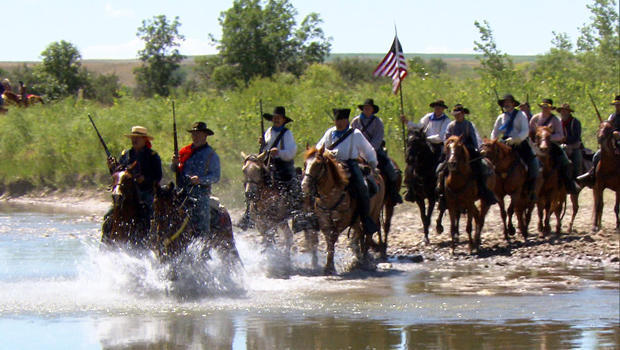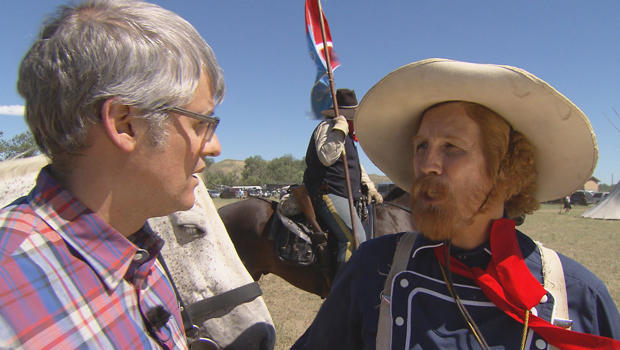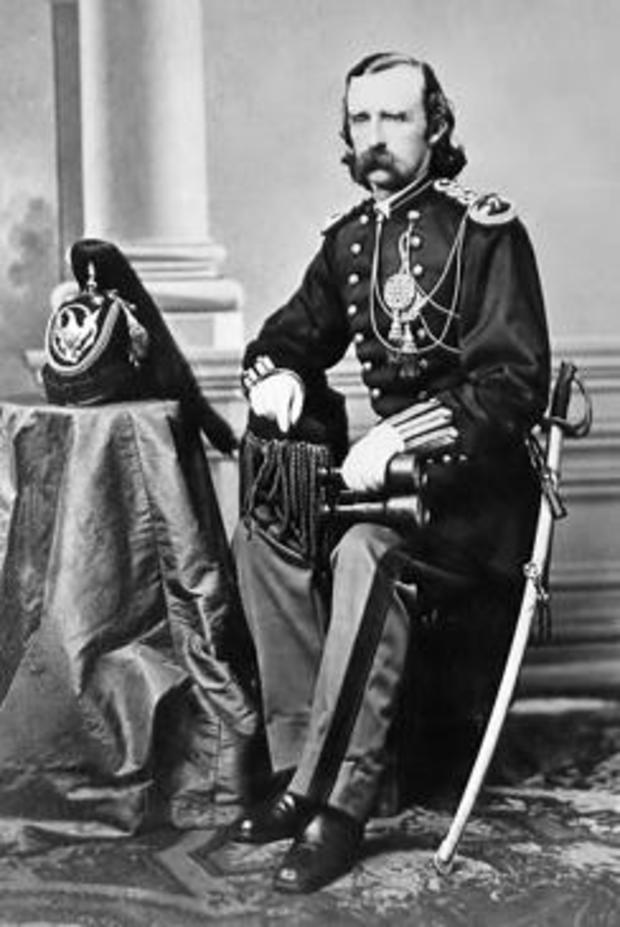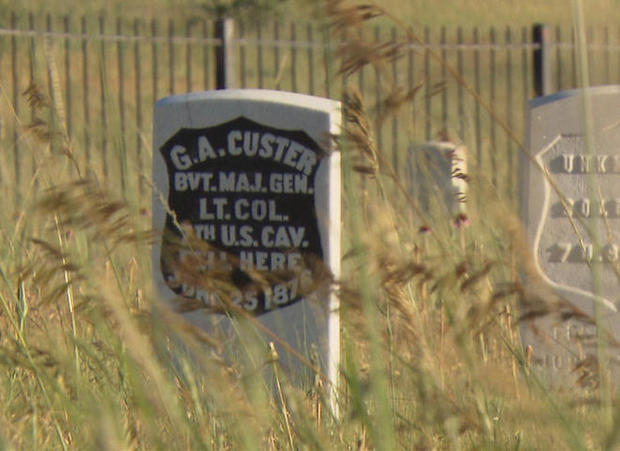Custer's Last Stand
The 141st anniversary of CUSTER'S LAST STAND is next Sunday. It turns out there's more to the story of that epic battle, as Mo Rocca now tells us:
Every summer, along the banks of Montana's Little Big Horn River, the strains of the 7th Cavalry's fight song are heard, as Col. George Armstrong Custer leads a bold charge on an Indian encampment, re-enacting the battle that took place here June 25, 1876.
Ranger Steve Adelson describes a terrifying cauldron of fear and violence: "The sky is raining arrows. Gunfire, smoke, yelling, screaming, cursing," he said. "Two Moons, the Cheyenne chief, [said], 'We swirled around the soldiers like water around a stone.' How long did the battle last? He said, 'About as long as it takes for a hungry man to eat his dinner.'"
In little more than an hour, Custer and more than 200 of his men were dead. The battle itself was short and decisive … its legacy anything but.
And the man at its center, says historian Nathaniel Philbrick, is as fiercely debated as ever.
"Custer is a lightning rod," he said. "He is one of those guys at the time he was living, people either loved him, worshipped him, or despised him, thought he was a fool."
"I think he was always reckless," said reenactor Jeff Reno. "But I think he was lucky, and his luck ran out right here.
Custer rushed into the camp, expecting the Indians would quickly leave, said reenactor Ty Birdinground. "But literally, he was entering the biggest encampment in Indian Country."
Reenactor Steve Alexander said, "Even though he captured more battle flags, more Confederate flags than any other officer during the war, the single day of his life, his last day, is what he's remembered for."
And how that day, and Custer, are remembered changes over time. "When I was a kid, he was the hero," said Philbrick. "Because I had seen "They Died With Their Boots On,' heroic portrayal. But then I think I was a freshman in high school and I saw 'Little Big Man, in which Custer is the deranged maniac, a caricature almost of a Vietnam-era imperialist."
As a youth, Custer didn't seem destined for greatness, finishing last in his class at West Point. According to Philbrick, Custer knew how to play the game of, "How bad can I behave and not get kicked out? And so for him, he was playing that line throughout his years at West Point."
"Who finished first in his class?" Rocca asked.
"Uh … Exactly. Who cares?"
But Custer's bravery in battle was unquestioned. A brigadier general for the Union Army at 23, he became a Civil War hero. At Gettysburg, he has his horse shot from underneath him. And when it looked like the Union Army might lose to the Confederates, "The person between them and that fate was Custer. And Custer and his Wolverines, the Michiganders, unleashed an incredible charge," Philbrick said.
Was he an adrenaline junkie? "Custer loved the thrill of anything," Philbrick said. "And there was nothing more thrilling than being in battle."
Except, perhaps, dressing up in black velvet uniforms adorned with gold braid.
"There are more pictures of Custer than any figure at that time," Philbrick said. "He's so vain. And he knows how to work the camera. I mean, this is the social media of its day."
"He would have been a monster on Instagram," said Rocca.
"Oh, yes. Instagram. And he could have done pretty well on Twitter, too!"
But by 1876, the Custer luster had faded. A military victory out West could restore some of that shine.
"He's 36, he's towards the end of his career," said Philbrick. "He has been dabbling in the stock market, silver mines, losing his shirt. He's got hopes of a lecture tour if he can come back a hero. He's desperate."
And the country, preparing to celebrate its centennial, was desperate, too -- for Indian land, including the gold-rich Black Hills of the Dakota Territory, land sacred to the Lakota, that the U.S. government had only years before granted to them "forever."
"The stakes were literally life and death for the Lakota," said Philbrick. "Their buffalo population, upon which they depended, had been decimated. The last remaining significant herd was in Montana. And that's why the Battle of Little Bighorn would be fought in that location."
Part of the battle took place on land owned today by brothers Jim and Henry Realbird. "We just swam along the river, and then we would find bullets and shell casings. That's from the battle," said Henry. The Realbird family has staged the annual reenactment for 26 years now.
What we know about the battle is that Custer met his match in Chief Sitting Bull.
"Sitting Bull, 45 years old, too old to fight, but not to lead," said Ranger Adelson. "He exhorts the warriors on -- 'Brave up, brave up, strong hearts to the front, cowards to the rear, Ho-Kay-Hay, it's a good day to die!'"
On that late June morning, Custer was undaunted by reports that his men were outnumbered by the Indians. "He's gone up again insurmountable odds, oftentimes during the Civil War, and come out victorious by being aggressive," said Ranger Adelson.
But the Indians did not run, and they did fight. It was "apocalyptic chaos."
George Armstrong Custer's mutilated body was recovered days later. "According to Lakota oral tradition, his ears had been pierced with awls so that he could hear better in the afterlife," said Philbrick.
And the expression on his face? "A smile. A triumphant smile, according to one witness. And that is just the mystery of Custer."
The victory for the Indians was short-lived. Within two years, most were confined to reservations.
It was, Ranger Adelson said, a battle over land: "Without a doubt. Land. Who would occupy it, how it would be used, and who would be allowed to traverse across it."
At the Little Bighorn Battlefield National Monument, Custer's men are memorialized where they fell. The Indian warriors who lost their lives are remembered, too, on what is today known as Last Stand Hill.
"This place talks to you, and you don't have to strain to hear it," Ranger Adelson said. "There's a mystical aura to it. It is a spiritual place."
For more info:
- Little Bighorn Battlefield National Monument, Crow Agency, Mont.
- "The Last Stand: Custer, Sitting Bull, and the Battle of the Little Bighorn" by Nathaniel Philbrick (Penguin); Also available in eBook, Digital Audio Download and Audio CD formats
- nathanielphilbrick.com
- Battle of the Little Bighorn Reenactment (June 23-25)








